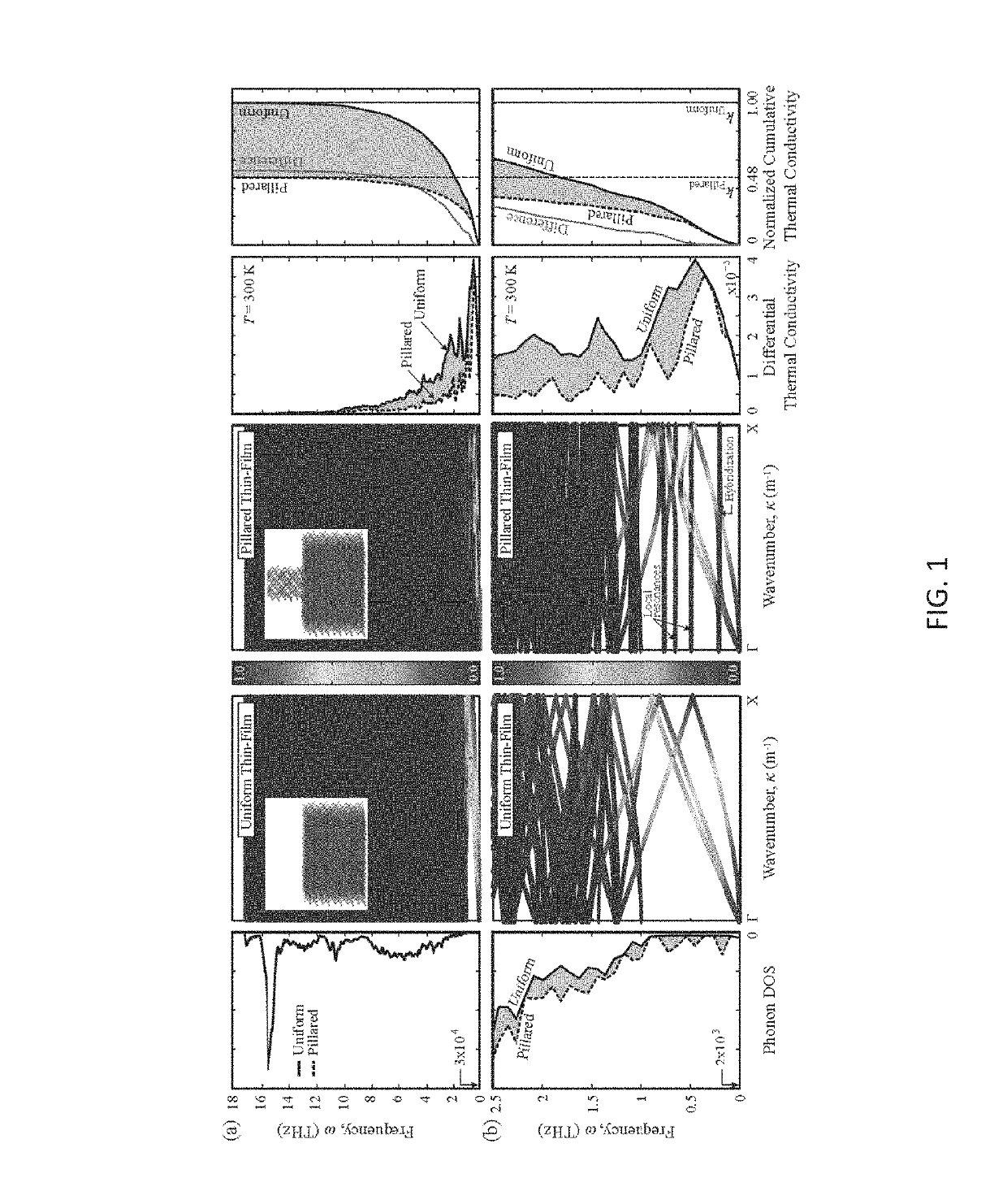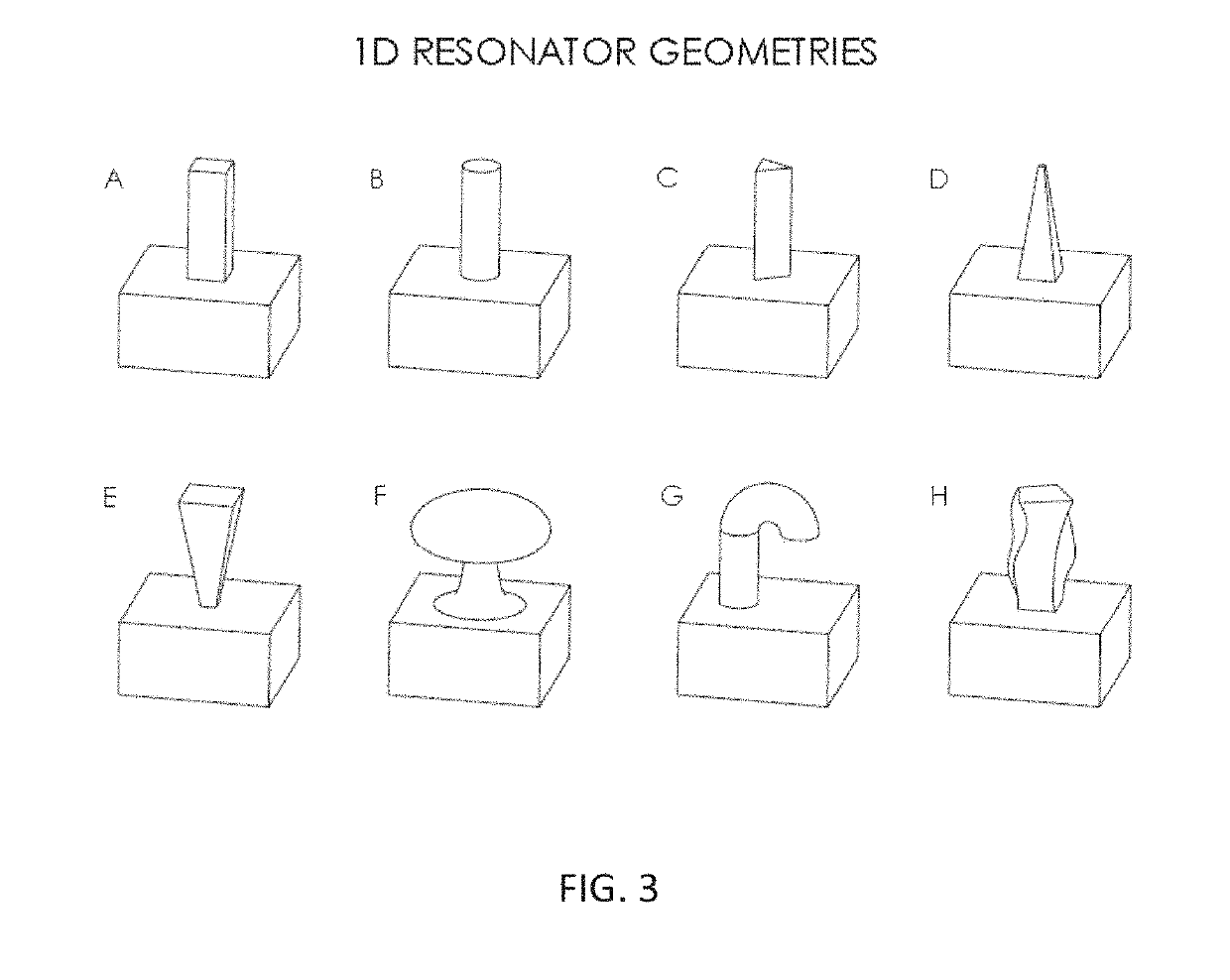[0011]The inclusions in these variations may include atomically ordered and / or atomically disordered material disposed within an at least partially crystalline base material (e.g., in bulk form) and / or layers / pillars / walls of atomically ordered and / or disordered materials disposed near, adjacent, or juxtaposed to an at least partially crystalline base material. In these implementations, the inclusions within the at least partially crystalline base material may be further disposed at least partially within (e.g., at least partially surrounded by) one or more layer of a compliant and / or slippable material, such as graphite, where one or more layer of atoms within the overall layer can vibrate or slip with respect to each other (e.g., with relatively low force) and thus enhance the resonace(s) of the inclusion and their transmission to the least partially crystalline base material.
[0012]In one implementation, for example, an at least partially crystalline base material provides a transport region for electron and phonon flow. At least one substructure, such as a pillar, wall, ring, plate or the like, extends from a surface of the base material and causes resonance hybridizations in the base material through movement of atoms of the extending substructure(s). The extending substructure, for example, may comprise an at least partially atomically ordered material (e.g., an at least partially crystalline material) and / or an atomically disordered (e.g., amorphous) material. In one particular implementation, for example, the base material may comprise a reduced-dimension base material, such as a thin film base material (e.g., a film or membrane base material). A plurality of substructures may extend from one or more surface of the reduced-dimension base material. Resonance hybridizations caused by atomic movements within the extended substructures, for example, may extend into a reduced dimension of the base material and interact with phonons flowing through a transport region of the base material. Thus, the interaction of the hybridizing resonances with the phonons traveling through the transport region of the base material may reduce the group velocities of the phonons, which, in some implementations, may further increase the effectiveness of reducing thermal conductivity in the base transport material.
[0013]In another implementation, for example, an at least partially crystalline base material includes one or more inclusions disposed within the at least partially crystalline base material. In one particular implementation, for example, the inclusion(s) are disposed within the base material adjacent to, juxtaposed and / or near a transport region that provides for electron and phonon flow through the base material. Movement of atoms within the inclusion(s) causes resonance hybridizations that extend into the transport region of the base material. The resonance hybridizations interact with phonons flowing through the transport region of the base material. The interaction of the hybridizing resonances with the phonons traveling through the transport region of the base material may reduce the group velocities of the phonons, which, in some implementations, may further increase the effectiveness of reducing thermal conductivity in the base transport material. By embedding the inclusions within the base material, for example, a bulk or discrete thermoelectric material may be produced.
[0014]In yet another implementation, for example, one or more resonance hybridization generated by atomic movement within an extending structure or inclusion local oscillator may be altered by including another material with a local oscillator. A different (e.g., relatively heavier or lighter material, relatively stiffer or softer material, etc.), for example, may be included with an atomically ordered or disordered extending substructure extending from the at least partially crystalline base material and / or with an inclusion disposed within the base material. The different material, for example, may alter one or more hybridizing resonance by affecting the atomic motions within the local oscillator(s). A relatively heavy or dense material added to the local oscillator, for example, may lower a frequency of one or frequencies of more hybridizing resonances and thus alter the interaction between the hybridizing resonances and phonons passing through the base material.
[0017]In another implementation, for example, a phononic metamaterial comprises at least one locally resonant pillar (e.g., nanoscale, microscale or milliscale pillar) extending from a surface of the at least partially crystalline base material. The extension of the one or more pillars from the base material may improve the thermoelectric energy conversion figure of merit, ZT, by freeing the at least partially crystalline base material from local resonators (or at least added local resonators) acting as internal scatterers that may hinder the motion of electrons and cause a reduction in electrical conductivity of the base material.
[0019]In another implementation, a phononic metamaterial structure is provided. The phononic metamaterial structure in this implementation includes: an at least partially crystalline base material configured to allow thermal conduction via a plurality of phonons moving through the base material; and at least one locally resonant oscillator coupled to the at least partially crystalline base material. The at least one locally resonant oscillator is configured to generate at least one vibration mode, such as a mode of atomic vibration, to interact with the plurality of phonons moving within the base material and slowing group velocities of at least a portion of the interacting phonons and reduce thermal conductivity through the base material
 Login to View More
Login to View More 


